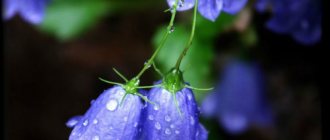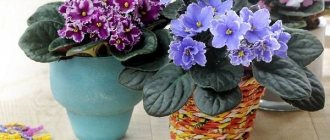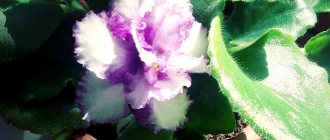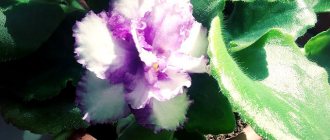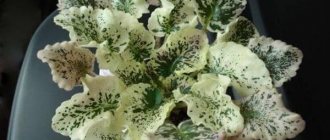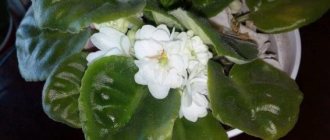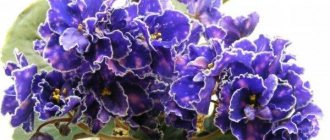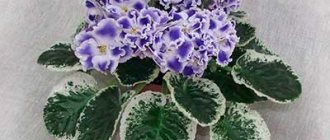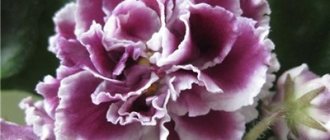One of the most popular flowers in the world is the violet. A report for the outside world in 2nd grade about this beautiful plant will help you find out where it grows, what it looks like, what types and varieties it has, and how to care for it. The violet, or viola, belongs to the Violet family.
It is found in the wild, but is very popular as a garden plant. Another name for the flower is pansy.
Growing violets
To prepare a report on violets in grade 2, it is not enough for schoolchildren to simply describe the plant . It is important to study its origin, growth characteristics and properties.
Garden violets have many qualities that make them attractive to grow. It is beautiful and sophisticated, very noticeable, despite its miniature size, easy to care for and blooms for a long time. Even novice gardeners can grow it even at home. It can be annual or perennial.
Violets originate from East Africa. In countries with a predominant temperate climate and subtropics (America, Australia and New Zealand) there are about 500 species of wild violets. In our country there are several hundred hybrids of the Violet family.
Many come from the pansy, or tricolor violet, a plant called the great-grandmother of modern hybrids.
Flower care
The plant prefers sunny places, but thrives in partial shade. The main requirement is fertile soil, loose with good drainage. Stagnation of water is detrimental to it. When planting, you should not plant flowers too close to each other; be sure to leave at least 10-15 cm between the bushes to avoid the risk of rotting of the roots.
Reproduction technology
The plant can be replanted from place to place at any time during the warm season. This will only have a beneficial effect on the development of the root system .
All types of violets can reproduce in several ways:
- seeds;
- cuttings;
- self-seeding.
The seeds are grown to produce an annual plant that will bloom in early summer. Seedlings are sown in February, and in May they are transplanted to a permanent place.
Cuttings are suitable for all types of viola. It is held in the summer, from May to the end of July. The cutting is the top of a green shoot, which must have at least 2-3 nodes. Fold it into soaked paper and dig it about 5 cm into the ground. It is advisable to choose a partial shade location for planting. It is important to remember that if you root at the very beginning of summer (May), they will bloom in the first year. If you take cuttings later (June, July), you will get a biennial plant, and it will bloom only in the second year.
Self-seeding is the easiest type of propagation. The gardener only needs to plant the sprouted seeds in early spring in a chosen location; using this method, a biennial plant is obtained.
Reproduction
Violet can be propagated in two ways: by cuttings and using seeds.
Propagation by seeds is more effective, since the sprouted stem is stronger and more stress-resistant than bushes after cuttings.
Violet can grow in winter at a temperature of 10 °C and without sun. The bush grows well under trees in gardens, but does not tolerate drought. Wild violets can be found in places where water accumulates. Spider mites can attack bushes if they don’t have enough moisture and air.
Interesting Facts
Few people know that the popular flower has found its use in cooking. In addition, it has long been used in traditional and folk medicine.
Use in cooking
The low calorie content of dishes using the plant allows you to enjoy the unusual taste and will help you maintain your figure. Candied spiced flower petals, packed in boxes with the image of Empress Elisabeth of Bavaria, are a flower dessert that is a souvenir calling card of the capital of Austria - Vienna.
There are unusual dishes with flowers of a beautiful plant: pastries, drinks, desserts. The most common:
- violet cake;
- dessert “violet tenderness”;
- violet cocktail;
- Everyone's favorite treat is ice cream.
Application in medicine
Information about the medicinal properties of violets has been known since ancient times. Some parts of the plant are classified as medicinal, especially the roots and rhizomes, and have been used in medicine since ancient times. When included in the diet, violet gives a high healing effect, since it contains micro- and macroelements that are vital for the human body:
- manganese;
- glycosides;
- iron;
- calcium;
- magnesium;
- vegetable acids;
- saponin;
- inulin;
- violin.
The healing properties of the plant have been proven: antispasmodic, choleretic, antiseptic. In pharmaceuticals, violet is used as part of breast herbal teas to soften and thin the mucus in dry coughs and colds.
The aroma of flowers does not cause any allergic reactions. Perfumers widely use flower extracts to create perfumes and body oils. In addition to the wonderful aroma, such oils have a soothing effect on the skin and relieve irritation.
From the story about the violet for grade 2, children get acquainted not only with the botanical diversity and characteristics of plants, but also learn that they have not only decorative properties, but also medicinal and many others.
Popular message topics
- Kitchen interior
Every person, after a busy day at school or work, rushes to his home to relax and do his daily chores. One of the rooms that exists in each apartment has a special purpose. - The role of animals in nature
Our animal world is diverse. The entire globe is filled with them, living almost everywhere: in water, in soil, on land. Animals have been keeping pace with humans for a long time. But few people think about what they are playing - Figure skating
is a magical sport. When you watch how easily the athletes glide across the ice and what tricks they perform, it seems easy and simple to do. But this is hard daily work. Athletes devote all their time and energy to training,
Varietal diversity
In the middle of the 20th century, about a hundred varieties of these indoor plants were bred, and today there are already more than 30 thousand of them, with about 2 thousand domestic ones. Moreover, every year, thanks to the careful work of breeders, the varietal number is growing rapidly.
For convenience, varieties are classified into groups, therefore, when describing a varietal violet, the type, color, shape of flowers, type and color of leaves, as well as the size of the plants are noted.
Flowers
Flowers with a diameter of 3 to 8 cm are simple, semi-double or double, and the petals themselves, both of the same size and of different sizes, can be corrugated, wavy, fringed.
The color of the petals can be either single-color snow-white, soft pink, pale blue and deep blue, red, burgundy, purple, or two- or multi-color. Flowers of many varieties have a border of a different color or stripes, spots, inclusions of various shades. One plant can bloom from several dozen to hundreds of flowers.
Goddess of Beauty (Korshunova)
Leaves
Most plants have leaf colors ranging from light to dark green, although there are other variations such as pure white, edged, or variegated with various patterns. The inside of the leaf may differ from the outside, sometimes radically, for example, have a purple color.
The history of violets in nature
Violet has another name - Saintpaulia . This is what leads to the secret of the opening of the flower. flowering plant with blue petals, bright yellow stamens in the center, and emerald leaves was found in Africa (a mountainous place called Uzambara) .
Uzambara violet in nature.
Saint-Paul , saw a beautiful bush . He was walking with his beloved woman when he came across a flower. The man was struck by the fact that the bush was located right on the stone, which was covered only by a small layer of moss. At the same time, the plant looked healthy and strong. The find greatly impressed the head of the colony, who had a curious disposition.
The governor sent a copy to his father in Europe. He, in turn, gave the seeds to scientists, who gave the plant the name Saintpaulia in honor of the governor of the colony.
Important! In 1893, Saintpaulia was presented at a large flower exhibition. Flower growers around the world immediately became interested in the discovery.
Various legends and stories about the violet
It is not for nothing that violet is one of the most adored plants among professional gardeners and amateurs. An indoor flower in a pot looks like a neat bright bouquet.
The history of the appearance of the plant is shrouded in legends, and the rapid rise in popularity is amazing. There are fairy tales and stories about violets. All these legends and stories about the violet contribute to its popularity.
Thanks to information about a flourishing culture, you can build a story for a child. To do this, you need to choose what you can rely on and know the basics for constructing a short report.
Children's stories
"Violet at the North Pole"
Among the stories about this flower, the work “Violet at the North Pole” (by Gianni Rodari) . It tells the story of Saintpaulia, which blossomed among the ice. She was noticed by polar bears and other animals. They began to discuss a previously unprecedented phenomenon, admired the beauty of the plant and enjoyed the pleasant aroma.
Violet tried her best to melt the snow and turn the area into a warm clearing. At night, when the animals fell asleep, the ice crackled and began to break under the influence of the wonderful aroma that the plant exuded. But the strength of the green bush quickly dried up, and by morning it withered.
Illustration for the fairy tale “Violet at the North Pole.”
"Young Wind"
Another story by an unknown author about this plant is called “Young Wind” . It talks about a young wind that witnessed the tender friendship of a boy and a girl.
Every day the children walked together and collected violets, and then wove wreaths. After some time, the boy had to leave, but such plants did not grow in his country.
Then the young wind asked his brothers to help and they lifted a huge number of violets into the air and carried them all over the world , including to where the boy lived.
As a result, despite the fact that friends lived in different countries, both the girl and the boy remembered each other all their lives thanks to the violets that grew next to them.
Fairy tale "Violet and Snowdrop"
An unusually touching tale about a violet about friendship and love (author M.A. Andrianov). The plot develops in a small clearing where a snowdrop and a beautiful violet have grown. They became friends.
One morning the violet noticed a caterpillar crawling towards a snowdrop to feast on its leaves. The brave beauty blocked the path and gave her petals and leaves to be eaten.
A little later, the snowdrop woke up and did not recognize her friend, who had lost some of her foliage and petals. Snowdrop decided not to communicate with such an ugly creature anymore.
Violet did not tell him what happened to her, but simply began to hide from her friend so as not to frighten him with her appearance. After a long time, the snowdrop saw a beautiful butterfly flying over the clearing. She sank down to him and began to ask if he had seen the damaged violet, which, defending its friend, gave itself up to be torn to pieces.
A clearing with violets, snowdrops and other primroses.
The snowdrop realized what had happened and began to call the violet. But the friend did not show up, then the butterfly itself flew to the place where the snowdrop was pointing. There lay a dried Saintpaulia. Snowdrop was very upset and cried for a long time.
But one day a butterfly with purple wings flew to him. She said that she used to be his friend violet and still loves him and is not offended by him . They became friends again.
Biological description
Saintpaulia violetflower, commonly known as violet uzambar (indoor violet), belongs to the genus Saintpaulia of the Gesneriev family. Under natural conditions, plants grow along rivers and near waterfalls in the Uzambara Mountains, which are located on the border of the two East African states of Tanzania and Kenya.
House violet is described as a perennial evergreen plant having:
- superficial root system;
- shortened succulent stem;
- basal rosette of leaves;
- long petioles;
- leaf blades up to 8 cm in size, covered with villi, leathery, broadly oval in shape with a slightly pointed tip;
- numerous small flowers collected in inflorescences;
- a calyx composed of 5 sepals;
- fruit in the form of a capsule with small seeds.
House violets are long-flowering indoor crops. If you provide the flower with suitable lighting and proper care, it will bloom for at least 9-10 months a year.
White Queen
